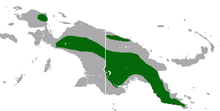Black-tailed New Guinea pouch mouse
| Black-tailed New Guinea pouch mouse | ||||||||||||
|---|---|---|---|---|---|---|---|---|---|---|---|---|
| Systematics | ||||||||||||
|
||||||||||||
| Scientific name | ||||||||||||
| Murexia melanurus | ||||||||||||
| ( Thomas , 1899) |
The black-tailed New Guinea pouch mouse ( Murexia melanurus ) occurs in the central highlands of New Guinea, in the Arfak Mountains in the northeast of the Vogelkop peninsula , in the Torricelli Mountains in the north of the Sandaun province and partly in the immediately adjacent lowland areas.
features
The males of the black-tailed New Guinea pouch mouse have a head-trunk length of 9.1 to 16.5 cm, a 10 to 16.5 cm long tail and weigh 26 to 69.5 g. Females stay significantly smaller with head and torso lengths of around 10 cm, tail lengths of 11 to 14.3 cm and a weight of 17 to 44 g. The size of the animals depends on the height of their habitat. Below 300 meters they can weigh over 60 g, while those from heights of around 2000 meters remain much smaller. The specimens living in the coastal Torricelli Mountains grow particularly large. They also differ from the rest of the black-tailed New Guinea pouch mice by their light fur. Features that distinguish the black-tailed New Guinea pouch mice from other New Guinea pouch mice are the black tail and chestnut-colored spots behind the ears.
Habitat and way of life
The black-tailed New Guinea pouch mouse is more common in secondary forests or pandanus bushes than in primary rainforests. It occurs from sea level to altitudes of 2800 meters above sea level and feeds mainly on invertebrates. Of the fecal samples examined by scientists, 96% contained the remains of beetles, Schnabelkerfe and spiders had a share of 56%, 48% had remains of grasshoppers , cockroaches had a share of 16% and 12% of the feces samples could to identify moths and butterflies, flies, earwigs, worms and bones and hairs of small vertebrates. The black-tailed New Guinea pouch mouse is probably primarily arboreal, active at night and builds nests from leaves to rest.
Reproduction
The animals are likely to reproduce throughout the year. Females have four pups, which corresponds to the number of their teats. The gestation period is around 22 days. The young animals leave the bag when they weigh 7 to 10 g and are suckled until they weigh 15 to 20 g. Then they stay with the female for a few months. Males become sexually mature at 8 months of age, females are then around 12 months old.
Danger
The IUCN classifies the black-tailed New Guinea pouch mouse as not endangered (least concern). It is widespread and there are several protected areas in its habitat.
Individual evidence
- ↑ a b c d e Andrew Baker: Family Dasyuridae (Carnivorous Marsupials). Pages 322-323 in Don E. Wilson , Russell A. Mittermeier : Handbook of the Mammals of the World - Volume 5. Monotremes and Marsupials. Lynx Editions, 2015, ISBN 978-84-96553-99-6
- ↑ Murexia melanurus in the Red List of Threatened Species of the IUCN 2016. Posted by: Leary, T., Seri, L., Wright, D., Hamilton, S., Helgen, K., Singadan, R., Menzies, J. , Allison, A., James, R., Dickman, C., Lunde, D., Aplin, K. & Woolley, P., 2015. Retrieved March 28, 2017.
